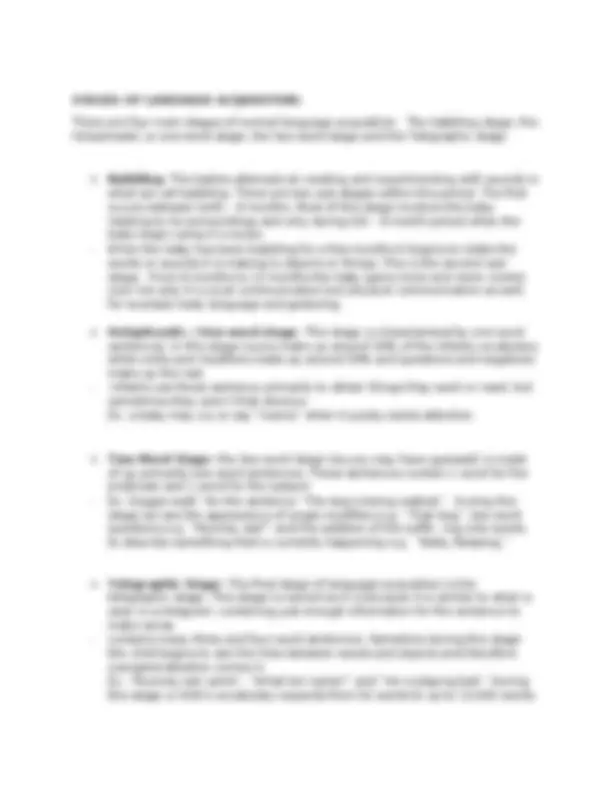




Study with the several resources on Docsity

Earn points by helping other students or get them with a premium plan


Prepare for your exams
Study with the several resources on Docsity

Earn points to download
Earn points by helping other students or get them with a premium plan
Community
Ask the community for help and clear up your study doubts
Discover the best universities in your country according to Docsity users
Free resources
Download our free guides on studying techniques, anxiety management strategies, and thesis advice from Docsity tutors
This document talks about language acquisition and its 3 theories and etc.
Typology: Study notes
1 / 4

This page cannot be seen from the preview
Don't miss anything!



Language acquisition- It is the mechanism by which people develop the ability to interpret and understand language (in other words, to acquire the ability to be conscious of and understand language), as well as to create and use words and phrases to communicate. First language acquisition refers to the way children learn their native language Second language acquisition refers to the learning of another language or languages besides the native language. Three Theories: The three theories of language acquisition are: imitation, reinforcement and analogy, do not explain very well how children acquire language. Imitation does not work because children produce sentences never heard before. Example: "cat stand up table." Even when they try to imitate adult speech, children cannot generate the same sentences because of their limited grammar. Reinforcement also does not work because it actually seldomly occurs and when it does, the reinforcement is correcting pronunciation or truthfulness, and not grammar. Example: A sentence such as "apples are purple" would be corrected more often because it is not true, as compared to a sentence such as "apples is red" regardless of the grammar. Analogy also cannot explain language acquisition. Analogy involves the formation of sentences or phrases by using other sentences as samples Example: If a child hears the sentence, "I painted a red barn," he can say, by analogy, "I painted a blue barn." Yet if he hears the sentence, "I painted a barn red," he cannot say "I saw a barn red." The analogy did not work this time, and this is not a sentence of English Acquisitions Phonology: A child’s error in pronunciation is not random, but rule-governed. Typical phonological rules include:
Innateness Hypothesis of child language acquisition, proposed by Noam Chomsky, states that the human species is pre-wired to acquire language, and that the kind of language is also determined. Poverty of the stimulus states that children seem to learn or know the aspects of grammar for which they receive no information. In addition, children do not produce sentences that could not be sentences in some human language. Critical Age Hypothesis suggests that there is a critical age for language acquisition without the need for special teaching or learning. Four skill areas of learning a foreign language need to be addressed consistently and continually. Good lesson plans incorporate all four: Listening, Speaking, Reading (and Vocabulary), and Writing (and Grammar).
- Native speakers do not learn the skill areas separately, nor do they use them separately, so they shouldn’t be taught separately. However, it is easy to fall into the trap of teaching about the language, instead of actually teaching the language.
At the end of this stage the child starts to incorporate plurals, joining words and attempts to get a grip on tenses.